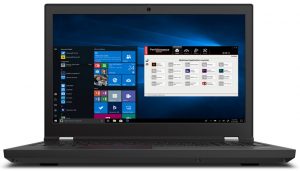Lenovo ThinkPad P15 Gen 2 – Top 5 Pros and Cons
 Now, this is a proper workstation. Yes, it is bulky and deserves a carrying case of its own, but the performance that it’s supposed to offer should be enough for you to at least consider it, as your next device.
Now, this is a proper workstation. Yes, it is bulky and deserves a carrying case of its own, but the performance that it’s supposed to offer should be enough for you to at least consider it, as your next device.
It has heavy-duty Tiger Lake H45 processors, as well as two Xeon processor options, which bring improvements of their own. The laptop isn’t light on graphics either, bringing professional-grade offerings from the new RTX A-series, as well as the slightly older Turing-based T-series.
Today we are presenting you with LaptopMedia’s top 5 picks about the Lenovo ThinkPad P15 Gen 2.
Lenovo ThinkPad P15 Gen 2: Full Specs / In-depth Review
4 reasons to BUY the Lenovo ThinkPad P15 Gen 2
1. Design and build quality
The laptop isn’t trying to hide its clunkiness and weight, and that is why it hasn’t tried to reduce it, coming with a profile of 31.45 mm at its thickest point, while also bringing a weight of 2.87 kg, which jumps up to 3.07 kg if you buy the touch-enabled model. This makes the notebook extremely rigid and structurally sound, especially when coupled with a material that is made from plastic and glass fiber composite. Typical for a ThinkPad, the branding is kept to a minimum, with only small Lenovo and ThinkPad logos on the lid.
Undoubtedly, the keyboard here is on point, just because it has so much room to play with. All in all, ThinkPad keyboards are always great, with very long key travel and very clicky feedback. It also has a backlight and spill resistance. There is also a Red TrackPoint, which comes with three physical buttons above the touchpad. The pad itself has a smaller size, along with a smooth Mylar cover, and accurate tracking.
2. Upgradeability
The upgradeability is more than ideal, with some people even going as far as to say it’s overkill. On the bottom panel, we see a service lid, which is there to allow for quick access to two SODIMM RAM slots and two M.2 PCIe x4 slots.
Next, you have to undo some more screws, which will set the keyboard loose. After you keep undoing more screws and some ribbon cables, which are fragile so be really careful, you can pull the unit away, revealing a lid that offers two more SODIMM slots and a third M.2 PCIe x4 slot. This results in the notebook being able to fit up to 128GB of DDR4 memory – both standard and ECC.
Here is our detailed teardown video, which shows how to access all of the seven total ports of the notebook.
3. I/O
The I/O is stacked, which is to be expected. There are ports on both the left, right, and rear. You get a total of two USB Type-A 3.2 (Gen. 1) ports, three USB Type-C 3.2 (Gen. 2) ports, two of which also have Thunderbolt 4 support, HDMI 2.1, and a LAN port, an SD card reader, and a 3.5mm audio jack.
4. Battery life
While the laptop houses some really power-hungry hardware, it also has a bulky battery to go with it. It has a size of 94Wh and performed well in our testing, lasting for 12 hours of Web browsing or 10 hours and 28 minutes of video playback. As with all of our battery tests, we have the Windows Better performance setting turned on, screen brightness adjusted to 120 nits, and all other programs turned off except for the one we are testing the notebook with.
1 reason NOT to buy the Lenovo ThinkPad P15 Gen 2
1. Cooling
The cooling of the laptop is immense as well, with a total of four thick heat pipes, which connect to four heat sinks. In addition, there is a heat spreader that cools both the VRMs and the graphics memory.
Max CPU load
In this test we use 100% on the CPU cores, monitoring their frequencies and chip temperature. The first column shows a computer’s reaction to a short load (2-10 seconds), the second column simulates a serious task (between 15 and 30 seconds), and the third column is a good indicator of how good the laptop is for long loads such as video rendering.
Average core frequency (base frequency + X); CPU temp.
| Intel Core i7-11850H (45W TDP) | 0:02 – 0:10 sec | 0:15 – 0:30 sec | 10:00 – 15:00 min |
|---|---|---|---|
| Lenovo ThinkPad P15 Gen 2 | 3.58 GHz (B+43%) @ 100°C @ 92W | 3.45 GHz (B+38%) @ 99°C @ 84W | 3.10 GHz (B+24%) @ 100°C @ 66W |
The CPU reaches critical temperatures, while maintaining a relatively low frequency, especially when compared to its non-vPro version: the i7-11800H.
Real-life gaming
| NVIDIA RTX A2000 | GPU frequency/ Core temp (after 2 min) | GPU frequency/ Core temp (after 30 min) |
|---|---|---|
| Lenovo ThinkPad P15 Gen 2 | 1780 MHz @ 81°C | 1742 MHz @ 86°C |
The GPU didn’t get as toasty, hovering around 85°C during our testing, while keeping a clock speed at around 1700-1800MHz.
Comfort during combined load
Regardless of the hellscape that is going on inside the system, the outside temperature is more than fine. The hotspot of the keyboard reaches a maximum temperature of 39°C.




















